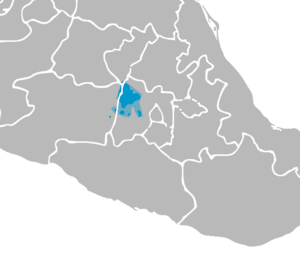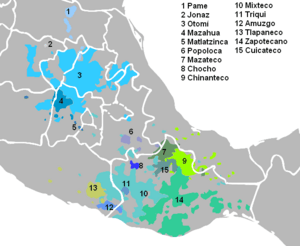Mazahua language facts for kids
Quick facts for kids Mazahua |
||||
|---|---|---|---|---|
| Jñatjo (mmc) Jñatrjo (maz) |
||||
| Region | Mexico: State of Mexico, Toluca | |||
| Ethnicity | Mazahua | |||
| Native speakers | 150,000 (2020 census)inali | |||
| Language family |
Oto-Manguean
|
|||
| Official status | ||||
| Regulated by | Secretaría de Educación Pública | |||

Extent of the Mazahua language in Mexico
|
||||

The Mazahua language, number 4 (darker blue), northwest
|
||||
|
||||
The Mazahua language (called Jñatrjo by its speakers) is spoken in the central states of Mexico. It is used by the Mazahua, who call themselves the Hñatho. This language is part of a group of languages found in Mesoamerica.
In 2003, the Mazahua language became an official language in Mexico. This happened through a special law called the General Law of Linguistic Rights of the Indigenous Peoples. This law made it equal to Spanish in areas where it is spoken. The largest number of Mazahua speakers live near Toluca, in a place called San Felipe del Progreso.
Contents
What is the Mazahua Language?
The Mazahua language is closely related to other languages like Otomi, Matlatzinca, and Ocuilteco/Tlahuica. These languages together form a smaller group called Otomian. This group is part of a larger language family known as Oto-Manguean.
Mazahua: A Tonal Language
Mazahua is a tonal language. This means that the meaning of a word can change based on the tone or pitch of your voice. For example, a word might mean one thing if you say it with a high pitch. It could mean something else if you say it with a low pitch. Mazahua uses high, low, and falling tones.
Many Sounds in Mazahua
The Mazahua language has a very large number of sounds, called phonemes. It has about sixty different sounds. This is twice as many as in the English language.
It has eight different vowel sounds. It also has seven special vowel sounds that are pronounced through the nose (nasal vowels). There are also up to forty-five different consonant sounds. Some of these sounds are quite rare in other languages. For example, it has "ejective" sounds, which are made by pushing air out quickly. It also has "implosive" sounds, made by sucking air in.
How Mazahua is Written
The way Mazahua is written is based on the Spanish alphabet. However, it has extra rules to show all its unique sounds.
- A line through a letter means the vowel sound is shorter or "reduced."
- An underline under a letter means the vowel is a "nasal vowel," pronounced through the nose.
- An apostrophe (') after a letter shows an "ejective" sound.
- The letter j after a consonant means the sound is "aspirated," like a puff of air.
- The letter u after a consonant means the sound is made with rounded lips.
Sample Text in Mazahua
Here is an example of the Mazahua language:
Texe yo nte̱'e̱ chjetrjoji, angezeji ximi xo'oji ñeje k'inchiji, nesta ra ngara na jo'o k'o dyaja e nte̱'e̱.
This means: (All human beings are born free and equal in dignity and rights. They are endowed with reason and conscience and should act towards one another in a spirit of brotherhood.)
Mazahua on the Radio
You can hear programs in the Mazahua language on the radio. The CDI has a radio station called XETUMI-AM. It broadcasts from Tuxpan, Michoacán.
See also
 In Spanish: Idioma mazahua para niños
In Spanish: Idioma mazahua para niños

